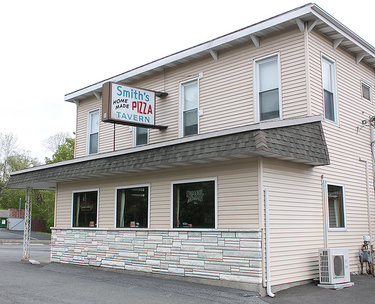Stewart’s says moratorium ‘ties our hands,’ village says it’s needed for good planning
VOORHEESVILLE — Because of a village moratorium on development, Stewart’s Shops is not now proceeding with the suit it had threatened when the Voorheesville Planning Commission required an in-depth environmental review.
“A building permit wouldn’t be issued regardless of the outcome of a suit,” said Chuck Marshall, who works in real-estate development for Stewart’s. “Like everyone else, we will sit and wait.”
The moratorium was adopted to allow a village-appointed committee to complete its work on Voorheesvsille’s first comprehensive land-use plan, which to be effective would have to be codified into law if the plan differs from the village’s current zoning.
The village board, by a vote of 4 to 1, adopted the development moratorium on June 27, two weeks after the meeting in which the planning commission insisted on an in-depth environmental review despite Stewart’s threat to sue. Trustee Jack Stevens cast the sole dissenting vote on the moratorium.
The large chain wants to build a store with gas pumps next to the Vly Creek and across from Voorheesville Elementary School. The commission is concerned about pedestrian safety as well as flooding and erosion. But Stewart’s Shops claimed the request for in-depth review is unlawful and merely a delaying tactic.
Marshall said that, of the over 300 shops operated by Stewart’s, “This is more than we’ve spent on any other approval process.” He said no other municipality had required an in-depth environmental review. When asked how much had been spent, Marshall answered simply “a lot.” He also could not estimate how much more an in-depth environmental review would cost.
Marshall had estimated earlier that building the Voorheesville Stewart’s, including gas pumps as well as the store, would cost about $1.5 million The June 9 letter threatening to sue stated that “the review effort has now cost Stewart’s $30,000 in Commission Engineering fees.”
The village law establishing the moratorium states that it will last for six months and may be extended by two additional six-month periods if the board so resolves.
Richard Reilly, the village’s attorney, told The Enterprise that Voorheesville first adopted “bare-bones” zoning in the 1950s. That 10-page document evolved over the years and the current zoning code was adopted in the mid-1980s. The code was amended twice since the start of this century but has never been tailored to a comprehensive plan, he said.
Reilly estimated the committee’s work will be completed by the end of the year. “At that point, we’d see if changes are needed to the code,” he said. “The code would benefit from an overall recodification, clarifying what we have adopted.”
Reilly maintained that the current moratorium was not adopted to thwart Stewart’s. “The comprehensive plan is something we’ve been talking about for a long time,” he said, noting there was a failed attempt at codifying a master plan in the 1970s.
“Stewart’s was only one of the issues last summer,” Reilly said. “The time was right to go through the comp plan process for the good of the community.”
Two conflicts last summer that filled the village hall meeting room — St. Matthew’s Church wanted to develop an apartment complex next to the church on Mountainview Street, and Stewart’s wanted to build a convenience store with gas pumps at on Maple Avenue — led the board to appoint a committee and hire a consultant to develop a master plan.
In September, the Voorheesville Village Board held a public hearing on a six-month moratorium to prevent any new gas pumps in the village. Mayor Robert Conway said at the time that the village proposed the moratorium because of longstanding concerns about water contamination.
Marshall then responded, “It’s more about zoning than water quality.”
Marshall said this week he would have preferred the “well moratorium.” He said, “That would have been over in six months.” He noted the current moratorium, with extensions, could last a year-and-a-half.
“By putting this moratorium in place,” Marshall said of the property Stewart’s now owns, “I can’t even sell it to a restaurant. Our hands are tied.”
After a year under contract, Stewart’s purchased the property at 112 Maple Ave., in the heart of the village, which had long been the home of the iconic Smith’s Tavern. The restaurant closed on May 27. Owners Jon D. McClelland and John H. Mellen sold the property to Stewart’s Shops Corp. for $750,000, according to Albany County records, which also show that McClelland and Mellen purchased the property in 1991 from Frank L. Smith Jr. and Gertrude R. Smith for $220,000.
Marshall went on, “We’re an approved use under the zoning.” Stewart’s wants to build a 3,675-square-foot store at the site, which is zoned commercially, but needs a special-use permit to put in gas pumps.
Marshall listed the studies that the planning commission had required and which Stewart’s paid for: on flooding, on wetlands, and on traffic — with two addendums.
He also cited the six-page document he had sent to the chairwoman of the planning commission, Georgia Gray, to answer concerns raised during April’s public hearing. On April 11, the planning had commission held a packed hearing on granting the special-use permit where 13 of the 21 speakers opposed the Stewart’s plan, five favored it, and three were in between. Most of the concerns focused on increased traffic, flooding, and safety.
“Stewart’s has been fully aware of the process,” said Reilly of the comprehensive plan committee and its work. “They’ve had representatives at some of the forums.”
Reilly said of the village board’s motivation in adopting the moratorium, “We really didn’t want to short-circuit the comp-plan process. We should let that process run its course and put things temporarily on hold.”
“The goal of the comprehensive plan is to provide for the orderly development and redevelopment of properties located within the Village and to ensure that uses within the Village are appropriately located in relation to each other and consistent with the community character of the Village,” says the moratorium law. “The village further seeks to evaluate the cumulative impacts of increased commercial uses within the Village and their impact on surrounding uses.”
The moratorium does not apply to residential subdivision of 15 units or fewer nor does it apply to applications for building permits for approved lots or structures for residential use.
Marshall concludes that the moratorium has created “a lot of uncertainty out there.” He said of the village, “They contemplated Moratorium One and didn’t proceed and then came back with Moratorium Two...For six months, the village has put an arbitrary ceiling on properties.”



